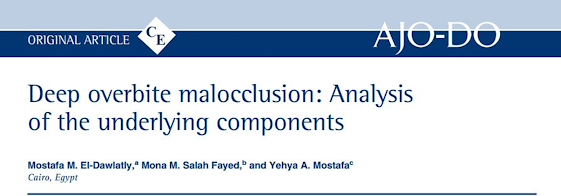Deep overbite malocclusion: Analysis of the underlying components (summary)
- Get link
- X
- Other Apps
This study aimed to analyze the various skeletal and dental components of deep bite malocclusion and their contributions to the problem. The researchers conducted a thorough analysis of all deep bite components to lead to more individualized treatment planning and mechanotherapy. The study found that an exaggerated curve of Spee and a decreased gonial angle were the greatest contributing components to deep bite malocclusion. The study analyzed 60 patients with deep bite malocclusion, and their cephalometric radiographs were used to measure the skeletal and dental components. The researchers measured the gonial angle, mandibular plane angle, maxillary and mandibular incisor inclinations, overbite, overjet, and curve of Spee. The results showed that the gonial angle was the highest contributing skeletal factor to a deep bite, and the exaggerated curve of Spee had the highest contributing dental component. The study also found that the lingual inclinations of the maxillary and mandibular incisors were among the least shared components. The authors suggest that a thorough analysis of all deep bite components can lead to more individualized treatment planning and mechanotherapy. The study's findings have significant implications for clinicians designing individualized mechanotherapies based on the underlying cause of the malocclusion. The authors suggest that clinicians should consider the specific skeletal and dental components contributing to the deep bite malocclusion when designing treatment plans. The study's results also highlight the importance of early intervention in deep bite malocclusion. The authors suggest that early intervention can prevent the development of more severe malocclusions and reduce the need for more invasive treatments later in life. In conclusion, this study provides valuable insights into the various components of deep bite malocclusion and their contributions to the problem. The findings can help clinicians design more effective treatment plans and improve patient outcomes. The study highlights the importance of early intervention in deep bite malocclusion to prevent the development of more severe malocclusions and reduce the need for more invasive treatments later in life. The study's results also emphasize the need for a thorough analysis of all deep bite components to lead to more individualized treatment planning and mechanotherapy. Overall, this study contributes to the understanding of deep bite malocclusion and can guide clinicians in providing better care for their patients.
- Get link
- X
- Other Apps



Comments
Post a Comment